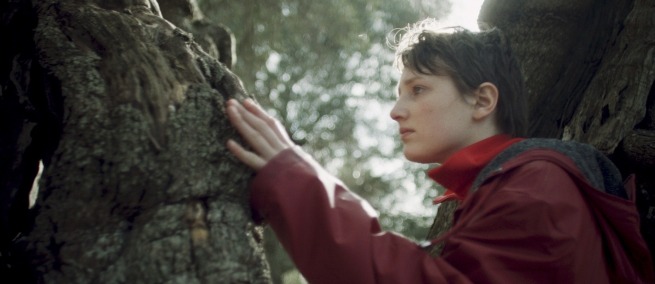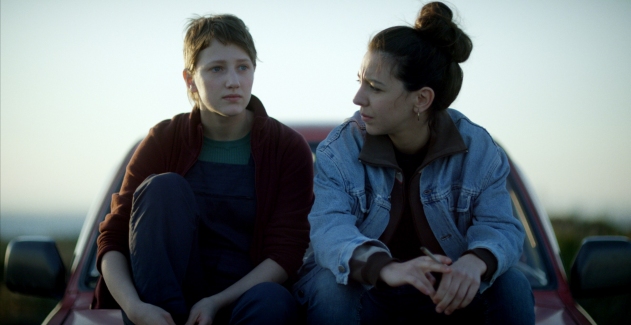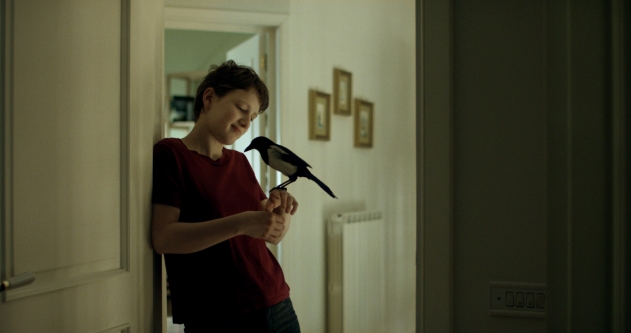
Written and directed by Danilo Caputo, SEMINA IL VENTO [SOW THE WIND] explores the significance of olive trees to Italians by telling the story of Nica, a student of agronomy with strong ties to the once healthy olive trees which are now plagued by a bug infestation. Intergenerational struggle comes into play when Nica attempts to save these relics, as her parents inch closer and closer to cutting them down. After its premiere at the Berlinale in the Panorama section, we sat down with Danilo Caputo and the film’s lead, Yile Yara Vianello who plays Nica, to learn more about the making of the film and the director’s perspective.
Science & Film: Danilo, in your introduction of the film at the premiere, you said this is an issue that is very close to you, and I wonder if you wanted to relate the film to a real-world problem?
Danilo Caputo: There are multiple issues that are based in reality: the problem with the [olive] trees, and also this thing that people sometimes do—accepting money to take toxic waste and put it in their land. We have a name for it in Italian, it’s the “eco mafia.” It’s a phenomenon where it’s cheaper for a firm to dispose of waste like that, so rather than disposing of it the proper way, which would be expensive, they just find a desperate peasant who is willing to do it.
We never really mentioned the city that we’re in. We also invented a different insect [that infests the olive trees], and the reason is that I didn’t want to make a film to point a finger on any of these topics, but rather to look for what’s common in all these phenomena. My idea is what’s common is that people have a certain mentality—it's the idea of mental pollution that comes up in the film. The character in the film says, “people are polluted in their head.” That was really the core of the issue for me.
The problem with the trees [in real life] is caused by bacteria. [For the film,] we invented an insect. The bacteria is very controversial, and universities are fighting against each other, and scientists don’t agree. There are a lot of plot theories; at the beginning, it was the idea Monsanto is responsible and was making money. It was such a mess, and it’s still such a mess, even after five years of that. So we decided that we didn’t want to add smoke to the fire. We didn’t want to make things worse by saying something. What if in the film [Nica] found the solution for the disease? And of course, we’re just screenwriters, so we didn’t want to do that.
S&F: Yile, I’m curious how you related to the character?
Yile Yara Vianello (translated): The relationship with the character was easy, because I am similar to the character myself, both in her relationship to nature and her behavior in different situations. I felt strongly this relationship with the family, especially with the generational gap between her and her father and mother. These two generations clash a lot in their ways of understanding the world.

Yile Yara Vianello and Feliciana Sibilano. © JbaOkta
SS&F: Daniel, how did you film the insects in the film?
DC: We didn’t film those. We found an entomologist that films insects as a strange hobby. So, he provided us with this footage. Actually, I discovered that filming a few seconds, like what we see in the film—the insect attacking another insect—is the result of he says sometimes 48 hours of being around the camera. You just have to wait, and then as soon as you see something happening you hit record.
Not a lot of insects have an action that’s so photogenic. First, we did a lot of research to find the right kind of insects, then we got the footage. With some VFX we changed it so it doesn’t look like anything that exists, because, once again, we wanted to make it clear that it’s a fictional world.
S&F: How did you find the entomologist?
DC: He’s a German entomologist. Online you can see some videos that he made, so we understood he had technical means and he could find the insects.
It was a real challenge, because he got the insects, and then some of them arrived dead, or he got the right pair and then nothing happened, and he said “I can’t guarantee that anything will happen because it depends on the season of the year, on the environment where they are, the smells…”
S&F: Can you explain the significance of olive trees in Italy?
DC: I think that the problem that we were talking about, what that makes clear is that olive trees are not just trees that you can cut away easily without hurting people’s feelings. Because people really reacted strongly to the idea that they were forced, and police came and tried to enforce the orders, to cut the trees down.
At that time, there were two different visions of trees becoming very clear. The olive trees in particular really represent something strong, symbolically, for Italians in general, but especially for the south of Italy where it’s almost all you see. For long stretches, you see olive trees, and they’re really part of our imaginary. They shape our memories, our childhood, and I don’t know, the way when I think of the landscape I think of olive trees, and when I think of our cuisine, it’s olive oil. It’s something very deeply rooted. Some of these trees are also centuries old, and there’s even a few that are millennia old. And they’re all at risk now because of the bacteria. It’s definitely touching a very deep chord in people. Right now, the problem is in Napoli, the region where the film was shot, but the bacteria advances 10 kilometers a year, and it can be carried by cars and stuff like that, so it has been spotted in France, as well as in Spain. So it’s a problem that risks becoming global.
I wanted to think about this human dynamic of people resisting and people crying over their olive trees being cut down. There was a science magazine in the U.S. that wrote a long article about the issue. They said that cutting down the trees is the only solution, but what the Italian government is doing wrongly is that they’re deeming this in a very light way. Because if someone is growing eggplant, and you cut them, you give them some money and they’re fine, they don’t care about the eggplants being cut. But these trees, sometimes they’re centuries old, and the Italian government needs to do some mediation. They need to have figures that mediate, that talk to the peasants, that explain that there is no alternative—this is horrible, but it has to happen—almost a psychological form of mediation. And, I don’t know, I thought this article was right on the point, because with the film I didn’t want to say that they shouldn’t be cut. But I wanted to show a character that’s deeply attached to those trees, and that’s willing to do everything to save them.
S&F: It’s unexpected that it’s the younger character who is so attached to the trees, not the parents.
DC: Yeah, it’s sort of counterintuitive in a way. It’s because her character grew up with the grandmother, who came from this world where, until the fifties, Italy was mainly rural in the South, and then, in the 50’s and 60’s, everything changed, and the generation of the parents in the film is a generation that grew up with this idea of modernity and the wealth that they thought was going to come along. Whereas now, young people, we have a very high unemployment rate, we have all the issues with the environment, and people are realizing that maybe going back to the fields, going back to work the fields, is not something… that there’s nothing shameful about it like the character of the mom thinks. It’s not going back to the Middle Ages, it’s just a way of living that can actually be fulfilling. And I guess that’s also a phenomenon that’s also true in the U.S.: that people are going back to farming in innovative ways.
SS&F: Yile, can you comment a little bit on Nica’s relationship to nature and if some of what Daniel said resonates with your own experience, or how you related to the characters?
YYV: I grew up in the North, not in Napoli but in Tuscany, in a village in the mountains. So the environment is different than Napoli but the relationship with the trees and with the nature is still very strong. We are very close to the nature surrounding. When I moved to the city, I realized how people around me, especially the grown-ups, have this myth of going out, like going to see the nature is something special, something particular. I think it’s very wrong to consider nature as something different from us, far away from us, something just for the holidays.

Yile Yara Vianello and Lady. © JbaOkta
S&F: Why did you choose to film with a magpie? I mean, they’re really beautiful, and they’re very charismatic. But they also have an interesting sort of cultural reference.
DC: In Italy we also say “thieving magpie” and stuff. But what I was attracted to was that, first of all, it’s very beautiful, and also that it’s a very ordinary bird in Italy. And I preferred it to other birds because I didn’t want it to be magic or ominous or to be exotic. I just wanted it to be the most banal thing. I never will see a magpie in the same way after doing this film, and I think that it’s interesting to take something that’s very banal and to put it under a different light. In Italy, magpies are a protected species, because I think that at some point their population was declining, so now they’re a protected species. So this magpie came from Poland. She had played in a film already, her name was Lady. Then she had this decline in her career, and she was in a cage for a long time, and then we gave her a second shot and she did it. I thought it was going to be really hard, and then Yile and she spent some time together, and the animal trainer told us right away that the bird really liked her. And, after pooping on her head a couple of times...everything went smoothly after.
S&F: How did you like acting with a magpie?
YYV: It was very nice, and very beautiful. And very funny.
S&F: I really appreciate the way you filmed the magpie and the trees.
DC: What we were trying to do is have some subjective shots from the magpie. So you see the magpie and what she looking at. I was always asking myself, how can I get the idea that nature is alive? Obviously the sounds do that, but how can I give this idea of the interiority, of the subjectivity, and the point of view shots really helped. I tried to play with things like that to challenge the way you look at things.

The cast and crew of SEMINA IL VENTO at the Berlinale. Photo by Sonia Epstein.
SEMINA IL VENTO was co-written by Milena Magnani and Danilo Caputo, directed by Caputo; filmed by Christos Karamanis, produced by Jacques Bidou, Marianne Dumoulin, Paolo Benzi, Konstantina Stavrianou, and Irini Vougioukalou; and features music by Valerio Camporini F. The film stars Yile Yara Vianello, Feliciana Sibilano, Caterina Valente, and Espedito Chionna. Pyramide International is representing it in worldwide sales.
TOPICS